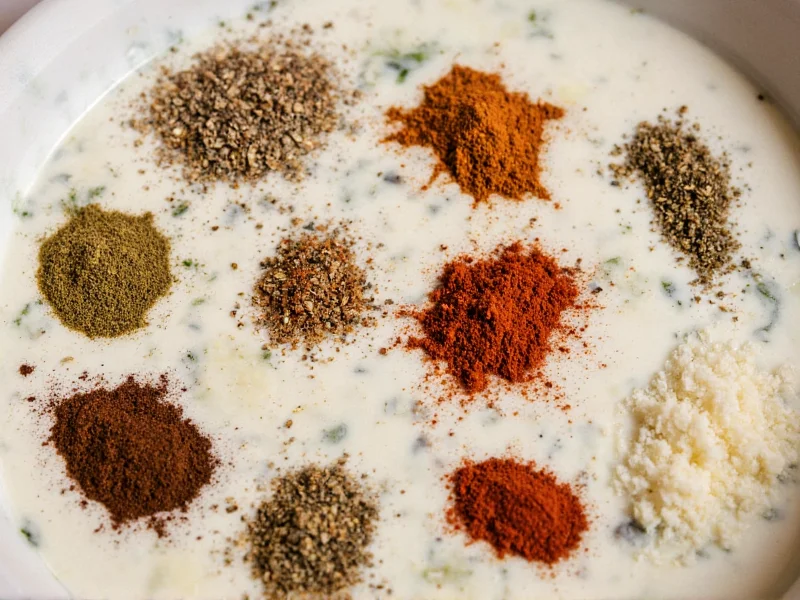When crafting authentic tzatziki, understanding the proper spice profile makes all the difference between a bland dip and a vibrant Mediterranean masterpiece. This Greek yogurt-cucumber sauce relies on a precise balance of flavors that enhance rather than mask its fresh ingredients. While regional variations exist, the core spice blend remains remarkably consistent across traditional recipes.
Essential Spices for Authentic Tzatziki
Garlic stands as the undisputed king of tzatziki spices. Freshly minced garlic provides the characteristic pungency that defines the sauce. The amount varies by preference, but most traditional recipes call for 1-2 cloves per cup of yogurt. Dill offers the second essential flavor component, contributing grassy, slightly sweet notes that complement both the garlic and cucumber. Fresh dill works significantly better than dried, which lacks the bright flavor needed.
Mint appears in many regional variations, particularly in Turkish and Middle Eastern interpretations of the sauce. While not universal in Greek tzatziki, a small amount of fresh mint (about 1 teaspoon per serving) can add a refreshing dimension without overwhelming the other flavors.
Supporting Flavor Elements
Though not technically spices, these ingredients work alongside your spice blend to create perfect tzatziki:
| Ingredient | Function | Recommended Amount |
|---|---|---|
| Fresh lemon juice | Acidity balance | 1-2 tbsp per cup of yogurt |
| Sea salt | Flavor enhancer | 1/2 tsp per cup of yogurt |
| Extra virgin olive oil | Richness and preservation | 1 tbsp per cup of yogurt |
Controversial Spice Additions
Some modern recipes suggest adding cumin to tzatziki, but this represents a significant departure from traditional Greek preparations. While cumin appears in some Turkish cacık (the Turkish version of tzatziki), it creates an entirely different flavor profile. Similarly, oregano and paprika occasionally appear in fusion recipes but lack historical authenticity.
When experimenting with non-traditional spices for tzatziki, consider these guidelines:
- Never add spices that dominate the delicate yogurt-cucumber balance
- Avoid dried herbs when fresh alternatives exist
- Introduce new spices one at a time to understand their impact
- Remember that tzatziki should enhance grilled meats, not compete with them
Regional Variations in Tzatziki Spice Profiles
Greek coastal regions often use more dill and less garlic, creating a lighter profile that complements fresh seafood. Inland Greek preparations typically feature stronger garlic presence to pair with heartier grilled meats. Turkish cacık frequently includes mint and occasionally a pinch of cumin, while Lebanese versions might incorporate sumac for additional tartness.
Timing Matters: When to Add Spices
The timing of spice incorporation significantly affects flavor development. For optimal results:
- Mix garlic with salt first to create a paste that distributes evenly
- Add fresh herbs after combining yogurt and cucumber
- Include lemon juice before herbs to prevent oxidation
- Refrigerate for at least 2 hours before serving to allow flavors to meld
This resting period allows the garlic to mellow while the dill infuses the yogurt. Many home cooks make the mistake of serving tzatziki immediately, resulting in harsh garlic flavor and disjointed spice notes.
Common Spice Mistakes to Avoid
Several pitfalls can ruin your tzatziki's spice balance:
- Using dried dill instead of fresh (creates a medicinal flavor)
- Adding garlic directly without mincing (creates uneven pockets of intense flavor)
- Over-salting (yogurt already contains salt, and cucumber releases water)
- Adding spices to warm yogurt (causes separation)
Perfecting Your Tzatziki Spice Blend
Mastering tzatziki spices requires attention to ingredient quality and proportions. Start with this basic ratio for 2 cups of finished sauce:
- 2 cups Greek yogurt (full fat)
- 1 medium cucumber, seeded and grated
- 2 garlic cloves, minced with 1/4 tsp salt
- 1 tbsp fresh dill, finely chopped
- 1 tsp fresh mint (optional)
- 1 tbsp lemon juice
- 1 tbsp extra virgin olive oil
- 1/4 tsp freshly ground black pepper
After mixing, refrigerate for 2-4 hours before serving. Taste and adjust seasoning just before serving, as flavors continue developing during chilling. The perfect tzatziki should have a subtle garlic presence with bright herbal notes that complement rather than dominate.
Storing Tzatziki with Proper Spice Considerations
Spice flavors continue evolving during storage. When making ahead:
- Reduce initial garlic by 25% (it intensifies over time)
- Hold back 25% of fresh herbs and add when serving
- Store in an airtight container with olive oil layer on top
- Consume within 3 days for optimal flavor balance
Understanding how spices behave in tzatziki ensures consistent results whether you're preparing it for immediate consumption or making it ahead for an event.











 浙公网安备
33010002000092号
浙公网安备
33010002000092号 浙B2-20120091-4
浙B2-20120091-4